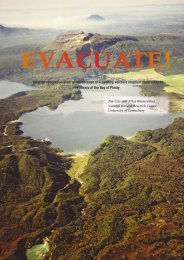Volcanoes - Ministry of Civil Defence and Emergency Management
Volcanoes - Ministry of Civil Defence and Emergency Management
Volcanoes - Ministry of Civil Defence and Emergency Management
You also want an ePaper? Increase the reach of your titles
YUMPU automatically turns print PDFs into web optimized ePapers that Google loves.
conditions, overloading <strong>of</strong> telephone systems due to<br />
increased dem<strong>and</strong>, direct damage to communications<br />
facilities, <strong>and</strong> indirect impacts resulting from disruption<br />
to electricity supplies, transportation or maintenance<br />
workers.<br />
Large quantities <strong>of</strong> electrically-charged ash<br />
can be generated in an eruption column. These<br />
cause interference to radio waves. However, there<br />
are also numerous examples <strong>of</strong> radio <strong>and</strong> telephone<br />
communications continuing to function around an<br />
erupting volcano <strong>and</strong> in areas receiving ashfalls (eg.<br />
Mount St Helens 1980, Pinatubo 1991 <strong>and</strong> Ruapehu<br />
1995-1996).<br />
Most modern telephone exchanges require<br />
air-conditioning units to keep electronic switching<br />
gear below critical temperatures. Exchanges with<br />
external air-conditioning units are thus vulnerable to<br />
over-heating if these units fail or are switched <strong>of</strong>f (due<br />
to ashfalls), even if the exchange itself is sealed. Any<br />
ash entering telephone exchanges can cause abrasion,<br />
corrosion <strong>and</strong>/or conductivity damage to electrical <strong>and</strong><br />
mechanical systems. Some exchanges are specially<br />
sealed to keep out corrosive geothermal gases (eg. in<br />
Taupo <strong>and</strong> Rotorua).<br />
IMPACT ON ANIMALS<br />
Ashfall is unlikely to immediately kill animals<br />
except when deposition rates are exceptionally high <strong>and</strong><br />
thickness is great. Ash cover on pastures may result<br />
in lack <strong>of</strong> feed for animals. Following ashfalls from<br />
Ruapehu in 1995 <strong>and</strong> 1996 farmers noted that animals<br />
were readily put <strong>of</strong>f their feed by ash deposits <strong>of</strong> around<br />
2-5 mm thickness. Some ashfalls have been poisonous<br />
to stock in Icel<strong>and</strong>, Chile <strong>and</strong> New Zeal<strong>and</strong>. Fluorine<br />
aerosols attached to ash pose the most significant<br />
threat to animal well-being. As a result <strong>of</strong> less than 5<br />
mm <strong>of</strong> ashfall on the Rangitaiki Plain (Taupo) during<br />
the 1995 Ruapehu eruption, approximately 2000<br />
ewes <strong>and</strong> lambs (2.5% <strong>of</strong> the area’s sheep population)<br />
were killed as a result <strong>of</strong> eating ash-affected pastures.<br />
Autopsies <strong>of</strong> the dead animals suggest fluorine poisoning<br />
or pregnancy toxaemia was the cause <strong>of</strong> death. The<br />
Department <strong>of</strong> Conservation also reported the death <strong>of</strong> a<br />
number <strong>of</strong> wild deer in Kaimanawa Ranges, downwind<br />
from Ruapehu, following the two largest October 1995<br />
eruptions (possibly up to 5 % <strong>of</strong> the sika deer population).<br />
IMPACT ON PLANTS<br />
Damage to small vegetation <strong>and</strong> the soils on<br />
which they depend will vary with ash thickness <strong>and</strong><br />
composition <strong>of</strong> the ash. Crop damage will result from<br />
burial which can kill or damage plants depending on<br />
the thickness <strong>of</strong> the ash <strong>and</strong> time <strong>of</strong> year. During the<br />
1995 Ruapehu eruption major losses (~$250 000) to<br />
cauliflower crops were reported in Gisborne, 250 km<br />
downwind but market gardens were fortunate that<br />
many crops were not in the ground at the time <strong>of</strong> the<br />
ashfalls. Ash adhered to healthy crops, especially fruit,<br />
may make processing uneconomical due to a need to<br />
clean individual pieces.<br />
Degradation <strong>of</strong> the organic fraction <strong>of</strong> soils may<br />
result from ashfall reducing the productive potential <strong>of</strong><br />
the area. However, small amounts <strong>of</strong> ash may improve<br />
soils. A positive impact <strong>of</strong> the 1995 - 1996 Ruapehu<br />
ashfalls has been to temporarily reduce the sulphur<br />
fertilizer requirement for all sheep, beef <strong>and</strong> dairy<br />
farmers within the ashfall area.<br />
SEDIMENTARY RESPONSE<br />
The impact <strong>of</strong> ashfall on hydrologic systems<br />
depends on a number <strong>of</strong> factors, including: thickness<br />
<strong>of</strong> the deposits; grain-size distribution; nature <strong>of</strong> the<br />
substrate (ie slope angle); degree <strong>of</strong> vegetation cover;<br />
<strong>and</strong> climate, in particular the intensity <strong>of</strong> precipitation.<br />
There are two main classes <strong>of</strong> impact:<br />
• hydrologic effects such as run-<strong>of</strong>f, flash-like stream<br />
discharges <strong>and</strong> higher flood peaks, due to enhanced<br />
surface run-<strong>of</strong>f <strong>and</strong> reduced infiltration rates in<br />
catchments.<br />
• erosion <strong>and</strong> resedimentation processes, which may<br />
be partly a function <strong>of</strong> the hydrologic effects <strong>and</strong><br />
which act to remobilise <strong>and</strong> redistribute the ash.<br />
The infilling <strong>and</strong> blockage <strong>of</strong> river valleys by<br />
pyroclastic flow deposits will trigger a more complex<br />
response than described above. Run-<strong>of</strong>f can pond to<br />
form small temporary lakes in depressions on the flow<br />
deposit’s surface or where drainages were blocked by<br />
natural barriers <strong>of</strong> pyroclastic material. Sudden releases<br />
<strong>of</strong> water from these lakes following the collapse <strong>of</strong><br />
their dams will create floods downstream. Upstream,<br />
erosion <strong>of</strong> pyroclastic valley fills by headward migrating<br />
channels may liberate large volumes <strong>of</strong> pumiceous<br />
material which causes downstream sedimentation<br />
over large areas for periods <strong>of</strong> decades. This has been<br />
well illustrated following the 1991 Pinatubo eruption.<br />
In New Zeal<strong>and</strong>, much <strong>of</strong> the Heretaunga Plains<br />
are covered by 4 - 8 m <strong>of</strong> pumice s<strong>and</strong>s <strong>and</strong> gravels<br />
underlying Hastings <strong>and</strong> Havelock North derived from<br />
the Taupo eruption 1800 years ago.<br />
Aquatic life is very susceptible to changes in<br />
water conditions such as increased acidity, turbidity,<br />
temperature <strong>and</strong> concentrations <strong>of</strong> soluble elements.<br />
Minor fish kills were also reported in ash-affected<br />
rivers after the 1995 Mt. Ruapehu eruption but were<br />
insignificant in terms <strong>of</strong> the total population. Minor<br />
disturbance to the 1995 trout spawning migration was<br />
observed but the Tongariro River fishery has generally<br />
remained in good condition. Fresh-water fish are not as<br />
capable <strong>of</strong> recolonising highly perturbed areas as some<br />
43<br />
TEPHRA<br />
June 2004

















